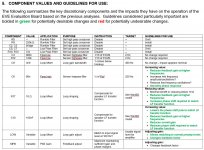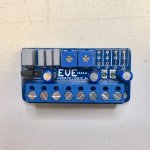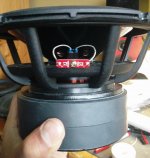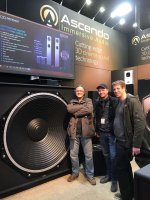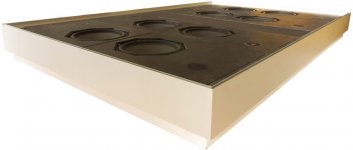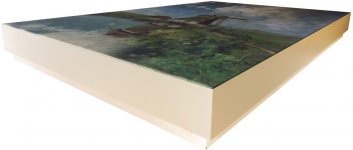Sound like it will be fine. 🙂
I like that you work on MFB. Not many people do it, while it is an effective way to improve low frequency performance.
To further push up Q and simultaneously reduce inductance related distortion (primarily 2nd harmonic), you could consider current drive. This can be implemented as another (inner) feed back loop, where the measured variable is voltage across a shunt resistor. It doubles the amount of work in designing the subwoofer though.
Maybe some day! But for now I'll be happy to get this working with a decent amount of feedback. 🙂 I'm also trying to keep the cost of this down for now and based on what I learn and how well it works, I might consider a more ambitious project later.
howdy, where do buy the MFB sensors? I can't find that part of the site.
Motional Feedback Audio.
Google starbass accelerometer. Motional Feedback Audio.
The optional components were ordered for populating the board based on the previous table. Some additional component values were purchased to allow for some tuning variability in C6, C10 and R17 later on. I also purchased an 8-position terminal block for external connections - this isn't in the parts list but is shown in a picture on Piratelogic's Facebook page.
Time to assemble the board! This is the first time I have used hot air and solder paste for SMD board assembly. After watching a few YouTube videos I purchased an inexpensive rework station and a syringe of solder paste and practiced on a sample board. After some tweaking of the nozzle size and air temperature and flowrate it seemed to work quite well and I added the surface mount components. Afterward, I did the standard through-hole parts. A top view of the completed board is shown below.
Time to assemble the board! This is the first time I have used hot air and solder paste for SMD board assembly. After watching a few YouTube videos I purchased an inexpensive rework station and a syringe of solder paste and practiced on a sample board. After some tweaking of the nozzle size and air temperature and flowrate it seemed to work quite well and I added the surface mount components. Afterward, I did the standard through-hole parts. A top view of the completed board is shown below.
Attachments
That's the spirit 🙂Rob said:I plan to repurpose these 'classic' drivers in a servo-feedback design or die trying.
howdy, where do buy the MFB sensors? I can't find that part of the site.
Motional Feedback Audio.
I'm close to updating the Piratelogic site with a whole bunch of new accelerometer developments such as the ClingOn which is geared towards drivers equipped with an extended polepiece that effectively disables the use of a StarBass.
For those who like to do some experimenting themselves, a limited number of V and VI prototypes is available via pb.
Attachments
That's the spirit 🙂
I'm close to updating the Piratelogic site with a whole bunch of new accelerometer developments such as the ClingOn which is geared towards drivers equipped with an extended polepiece that effectively disables the use of a StarBass.
For those who like to do some experimenting themselves, a limited number of V and VI prototypes is available via pb.
This is very exciting, I have been wanting to try MFB for years but have not had the time was development of sensors. There is some good info here:
Audio Design Principles
That's the spirit 🙂
Confidence is not my forte, Chris. 😉
I'm close to updating the Piratelogic site with a whole bunch of new accelerometer developments such as the ClingOn which is geared towards drivers equipped with an extended polepiece that effectively disables the use of a StarBass.
Hmmm. In this situation, maybe sometimes a tubular "voice coil former extender" might be an option to allow the use of a Starbass?
For those who like to do some experimenting themselves, a limited number of V and VI prototypes is available via pb.
What is "pb" in this context?
I'm not sure what distinguishes a driver with an extended polepeice? do you mean the magnetic polepeice prevents attaching the sensor to the voice coil somehow? is this a typical construction on high xmax drivers?
Would the new sensors be suitable for 18" drivers?
Would the new sensors be suitable for 18" drivers?
An extended pole piece is a pole piece that extends beyond the front pole plate. It is used to improve BL linearity and coil cooling. With extended pole piece, the sensor can no longer be mounted inside of the voice coil.
Extended Pole Piece
Extended Pole Piece
Last edited:
It rarely is with professionals.Confidence is not my forte, Chris. 😉
That pretty much outlines my original take, my reason for not pursuing it further was with fear for resonances, it's impact on dustdome cosmetics and it's lowish KISS score 🙂Hmmm. In this situation, maybe sometimes a tubular "voice coil former extender" might be an option to allow the use of a Starbass?
Would the new sensors be suitable for 18" drivers?
I can't think of a reason why not. PirateLogic has accelerometer assemblies for larger voice coils and the variable component values should accommodate the performance differences.
This loudspeaker might be slightly larger than 18". 🙂
Piratelogic - ISE2019 in a nutshell. Thanks for being a... | Facebook
Attachments
Personally I would rather go for 8 x 12" because controlling a 4kg cone could proof troublesome 😱
Can you elaborate on this, Chris? Is it just the large power requirement for MFB below system electro-mechanical Fs or is there more to it than that?
Consider breake up.
I would say that 15 or 18" is ok since those are standard parts.
9*18" will also have 8 ohms. And you could have one accelerometer.
9 voice coils couples to the air much better. Giving also much higher frequenzy range upwards.
I would say that 15 or 18" is ok since those are standard parts.
9*18" will also have 8 ohms. And you could have one accelerometer.
9 voice coils couples to the air much better. Giving also much higher frequenzy range upwards.
The larger the driver gets
Have a look at what PS audio is doing, they are running a series of relatively small drivers in parallel to build SPL. You won't believe what daisychaining MFB drivers does to SPL until you've heard it.
Below some images of a 15 cm deep servo painting we did a while ago sporting 8 individually corrected 7 inch drivers. It was used as a conference PA and fooled everybody inside into thinking it was just a painting. Until it started producing 30hz dubstep out of the blue
- the larger its cone will be
- the more difficult it gets for it to remain acting like a piston
- the earlier breakup will occur
- the less MFB will be able suppress D2, D3
- the heavier it gets
- the more energy is needed to quickly move it around
- the less capable it will be to quickly respond to transients
- the worse its impuls response will be.
- the lower its maximum frequency will be.
- the more difficult it gets for it to remain acting like a piston
Have a look at what PS audio is doing, they are running a series of relatively small drivers in parallel to build SPL. You won't believe what daisychaining MFB drivers does to SPL until you've heard it.
Below some images of a 15 cm deep servo painting we did a while ago sporting 8 individually corrected 7 inch drivers. It was used as a conference PA and fooled everybody inside into thinking it was just a painting. Until it started producing 30hz dubstep out of the blue

Attachments
Last edited:
Hi Chris.
That is a cool picture! "Invisibass" 🙂
I have mixed some comments in with your reply. Forgive me for being somewhat contrary to illustrate another way of looking at the use of larger drivers. Rebuttals welcome! 🙂
No doubt! 🙂
Yes but only at higher frequencies that are likely to be beyond the practical bandwidth of the large driver
Yes but as above the larger driver is less suitable for higher frequency reproduction anyways
This is a claim I don't follow. It will take more power, but otherwise I see no difference in the ability to suppress distortion for a given feedback factor at a given frequency.
Yes
The higher mass of the larger driver reduces acceleration but the larger diaphragm is compensatory.
Newton's second law applies regardless and the larger driver still responds quickly in the sense that in the mass-dependent region the phase relationship with the amplifier signal is still maintained though amplitude is less. And with less practical bandwidth, the larger driver doesn't need as short a rise time to do its job accurately.
See above.
Yes, but as above, this matters less or not at all depending on the bandwidth it is being asked to reproduce.
Yes
That is a cool picture! "Invisibass" 🙂
I have mixed some comments in with your reply. Forgive me for being somewhat contrary to illustrate another way of looking at the use of larger drivers. Rebuttals welcome! 🙂
The larger the driver gets
the larger its cone will be
No doubt! 🙂
the more difficult it gets for it to remain acting like a piston
Yes but only at higher frequencies that are likely to be beyond the practical bandwidth of the large driver
the earlier breakup will occur
Yes but as above the larger driver is less suitable for higher frequency reproduction anyways
the less MFB will be able suppress D2, D3
This is a claim I don't follow. It will take more power, but otherwise I see no difference in the ability to suppress distortion for a given feedback factor at a given frequency.
the heavier it gets
Yes
the more energy is needed to quickly move it around
The higher mass of the larger driver reduces acceleration but the larger diaphragm is compensatory.
Newton's second law applies regardless and the larger driver still responds quickly in the sense that in the mass-dependent region the phase relationship with the amplifier signal is still maintained though amplitude is less. And with less practical bandwidth, the larger driver doesn't need as short a rise time to do its job accurately.
the less capable it will be to quickly respond to transients
See above.
the worse its impulse response will be
Yes, but as above, this matters less or not at all depending on the bandwidth it is being asked to reproduce.
the lower its maximum frequency will be
Yes
The D2, D3 claim is with their reduction becoming increasingly difficult the larger the cone gets, resulting in a very limited frequency range mfb is able to do it's thd suppressive work in.
MFB will work with larger drivers, no doubt, it's just for me that the area is of no interest. Most PA systems are build for SPL and if for whatever reason it's bottom needs expanding they just throw in some extra bins as space is no frontier. With large bass bins in mind THD reduction is no issue, it just needs to play loud.
The same more or less applies to open baffles, although I really appreciate the unboxed response a well designed system exhibits I find it hard to believe any average female will appreciate a couple of extra doors in the house.
MFB's unique selling point is with it's ability to produce 30hz from 3 liters with an SPL level which suits most average households 95% of the time. It's a design choice.
MFB will work with larger drivers, no doubt, it's just for me that the area is of no interest. Most PA systems are build for SPL and if for whatever reason it's bottom needs expanding they just throw in some extra bins as space is no frontier. With large bass bins in mind THD reduction is no issue, it just needs to play loud.
The same more or less applies to open baffles, although I really appreciate the unboxed response a well designed system exhibits I find it hard to believe any average female will appreciate a couple of extra doors in the house.
MFB's unique selling point is with it's ability to produce 30hz from 3 liters with an SPL level which suits most average households 95% of the time. It's a design choice.
- Home
- Loudspeakers
- Subwoofers
- MFB for ACI SV12 Drivers using Piratelogic Electronics
